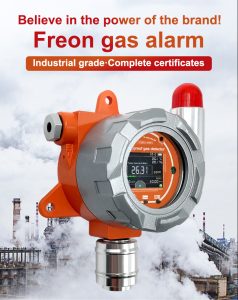-
Detecting Hazardous Gases: How Gas Sensors Improve Workplace Safety
- Workplace safety is a critical concern for employers and employees alike. Hazardous gases, such as carbon monoxide, hydrogen sulfide, and methane, can pose significant risks to worker health and safety. Exposure to these gases can lead to……
- Chat Online
-
Description
Workplace safety is a critical concern for employers and employees alike. Hazardous gases, such as carbon monoxide, hydrogen sulfide, and methane, can pose significant risks to worker health and safety. Exposure to these gases can lead to serious health effects, including respiratory failure, suffocation, and even death. Therefore, it is essential to have effective gas detection systems in place to monitor and detect hazardous gases in the workplace. This article explores the importance of gas sensors in improving workplace safety and their role in protecting workers from the dangers of hazardous gases.

Understanding Gas Sensors
Gas sensors are devices that detect and measure the presence of specific gases in the air. These sensors work by converting the gas concentration into an electrical signal, which is then analyzed and interpreted by a control system. Gas sensors can be calibrated to detect a range of gases, including toxic gases, flammable gases, and combustible gases.
Types of Gas Sensors
There are several types of gas sensors available, each with its own set of advantages and limitations. The most common types of gas sensors include electrochemical sensors, infrared sensors, and catalytic sensors.
Electrochemical sensors are designed to detect toxic or hazardous gases and are commonly used in industrial settings. These sensors use a chemical reaction to convert the gas into an electrical signal, and they are highly sensitive and accurate.
Infrared sensors are used to detect flammable gases and are commonly found in gas leak detectors. These sensors work by measuring the absorption of infrared radiation by the gas molecules, and they are highly selective and sensitive.
Catalytic sensors are used to detect combustible gases and are commonly found in gas detectors used in confined spaces. These sensors work by measuring the heat generated by a catalytic reaction between the gas and a catalyst material, and they are highly sensitive and reliable.
Importance of Gas Sensors in Workplace Safety
Gas sensors play a crucial role in workplace safety by detecting the presence of hazardous gases and alerting workers to potential dangers. By providing real-time information about gas concentrations, gas sensors enable workers to take appropriate safety measures, such as evacuating the area or wearing protective equipment.
In addition to protecting workers from immediate hazards, gas sensors can also help prevent long-term health effects associated with exposure to hazardous gases. By detecting low levels of toxic gases, such as carbon monoxide, gas sensors can alert workers to the need for improved ventilation or other measures to reduce exposure.
Benefits of Gas Sensors in the Workplace

The benefits of gas sensors in the workplace are numerous. By providing real-time feedback on gas concentrations, gas sensors can improve worker safety and reduce the risk of accidents and injuries. Additionally, gas sensors can help employers comply with regulatory requirements, such as OSHA standards for exposure limits to hazardous substances.
Gas sensors can also contribute to improved efficiency and productivity in the workplace. By detecting gas leaks and other hazards early, workers can take corrective action before incidents occur, reducing downtime and minimizing disruptions to work processes.
Challenges with Gas Sensors
While gas sensors offer many benefits, there are also some challenges associated with their use. One common challenge is ensuring that gas sensors are calibrated correctly and maintained properly to ensure accurate readings. Additionally, gas sensors can be affected by environmental factors, such as temperature and humidity, which can impact their performance.
Another challenge with gas sensors is the potential for false alarms. In some cases, gas sensors may detect low levels of gas that do not pose an immediate danger, leading to unnecessary evacuations or disruptions in work processes. Therefore, it is important to carefully evaluate the sensitivity and specificity of gas sensors and to implement appropriate measures to minimize false alarms.
Future Implications of Gas Sensors
As technology continues to advance, gas sensors are becoming more sophisticated and accessible. Advances in sensor technology, such as miniaturization and wireless connectivity, are making it easier to deploy gas sensors in a variety of settings, including remote or inaccessible locations.
Additionally, the integration of AI and machine learning algorithms can enhance the capabilities of gas sensors, allowing for more accurate and precise detection of hazardous gases. This technology could enable gas sensors to detect subtle changes in gas concentrations or identify new types of hazardous gases, improving worker safety and reducing the risk of workplace accidents and injuries.
Conclusion
Gas sensors play a critical role in improving workplace safety by detecting and measuring the presence of hazardous gases. By providing real-time feedback on gas concentrations, gas sensors enable workers to take appropriate safety measures, reducing the risk of accidents and injuries. While there are some challenges associated with gas sensors, advances in technology are making them more reliable and effective than ever before. As workplaces continue to prioritize safety and compliance with regulatory requirements, gas sensors will remain an important tool for protecting workers from the dangers of hazardous gases.
-
Recommend:
-
-
Gas detectors are crucial devices used in various industrie…
-
How do gas detectors ensure industrial safety?
Gas detectors play a crucial role in ensuring the safety of…
-
How Gas Sensors Help Combat Air Pollution?
Air pollution is a pressing global issue that poses signifi…
-
How can gas sensors be used in air quality monitoring?
Air pollution is a significant global concern that affects …
-
 : +86 155 8830 2704
: +86 155 8830 2704 : jxdziot@gmail.com
: jxdziot@gmail.com
